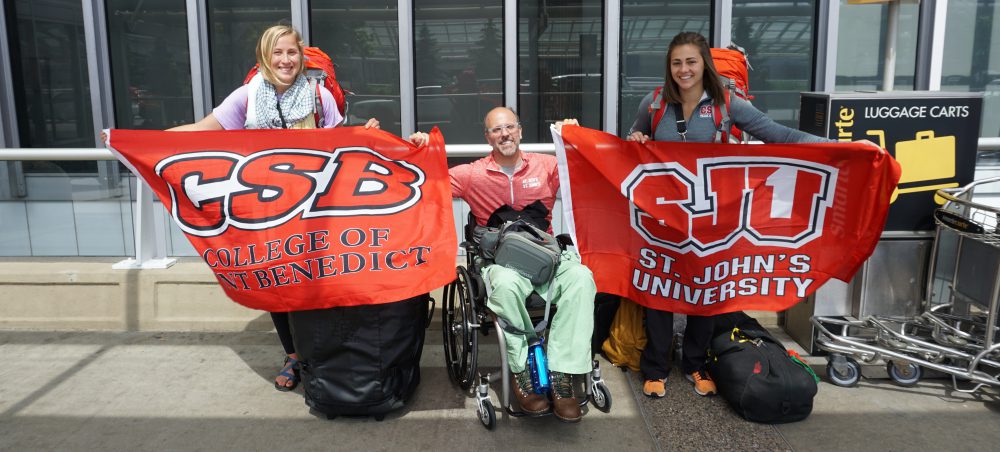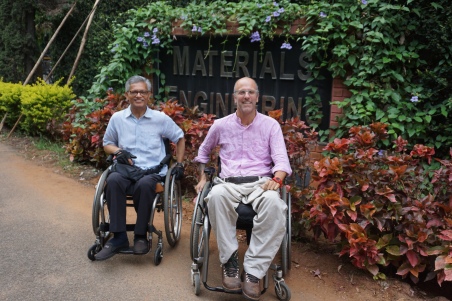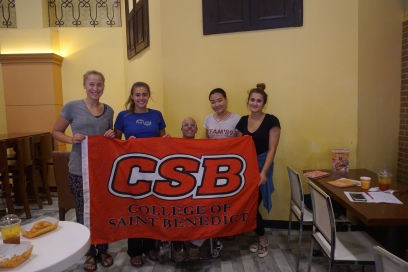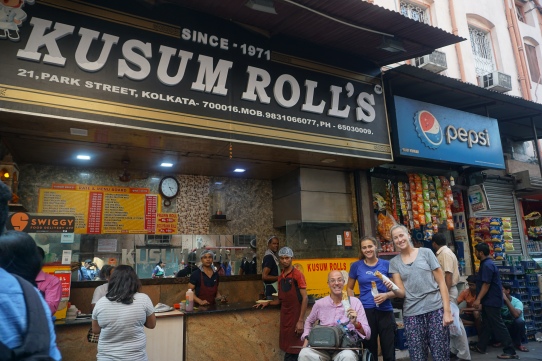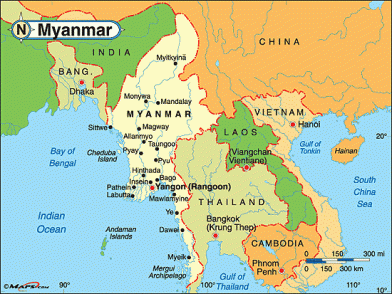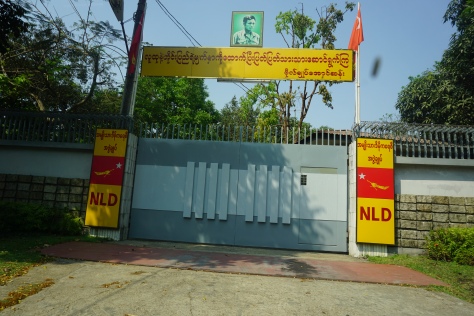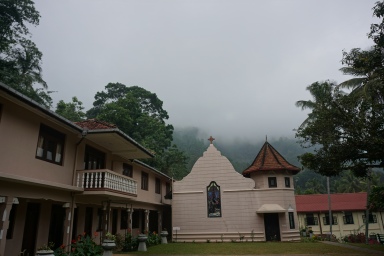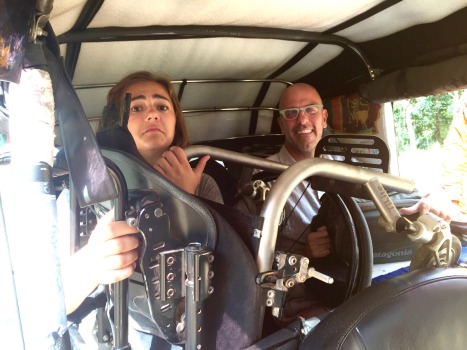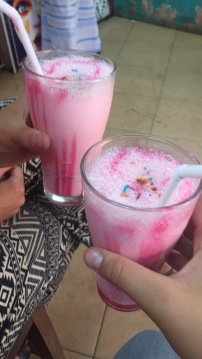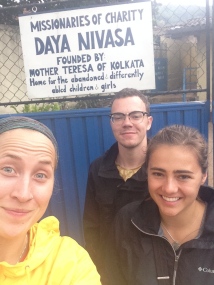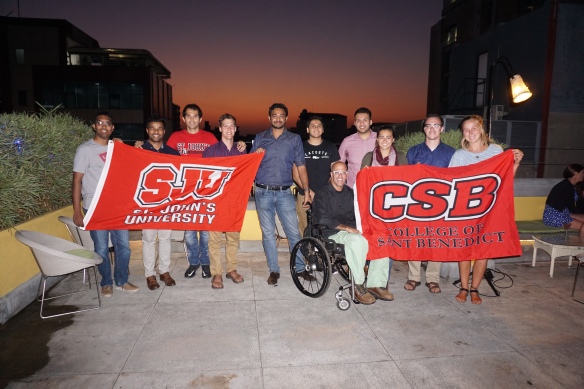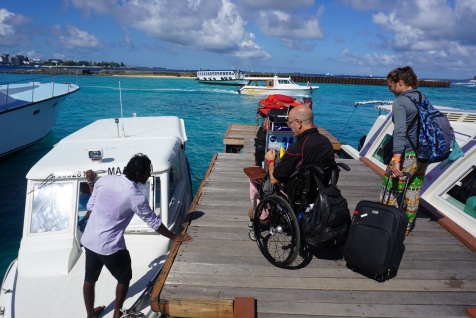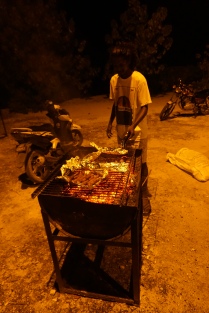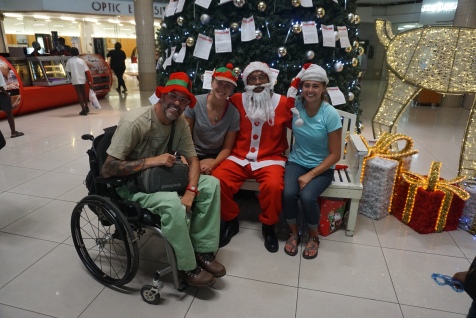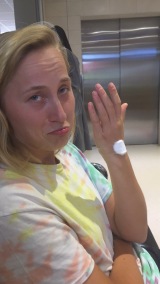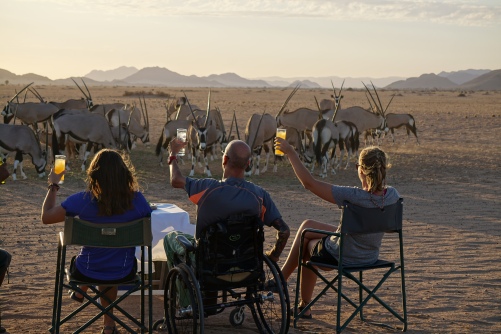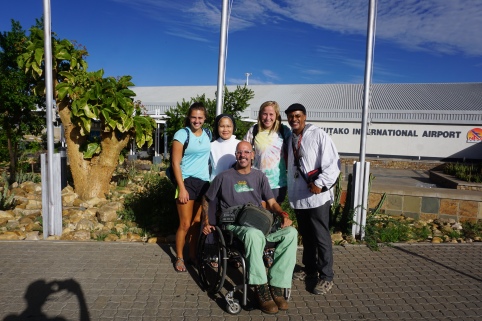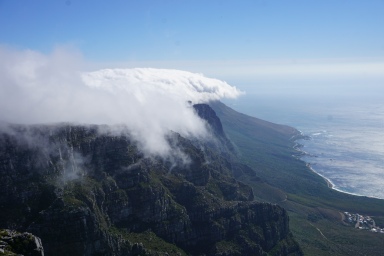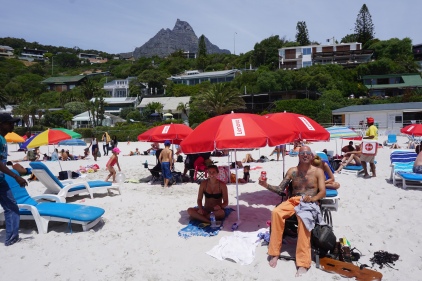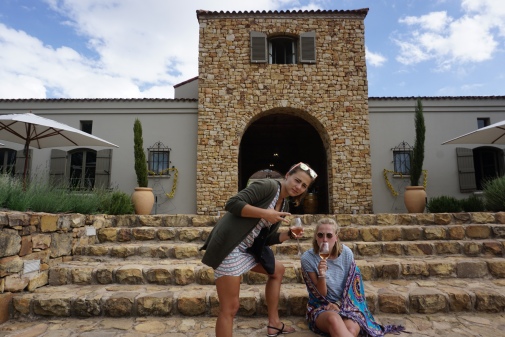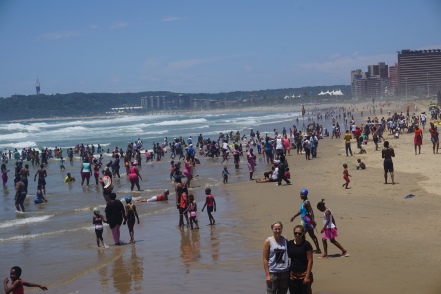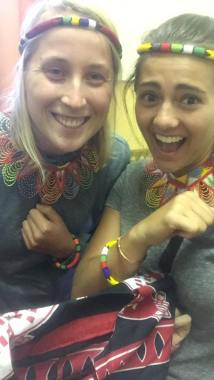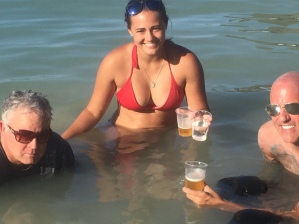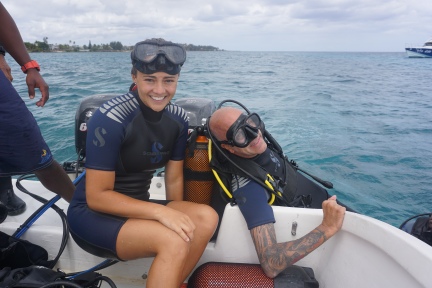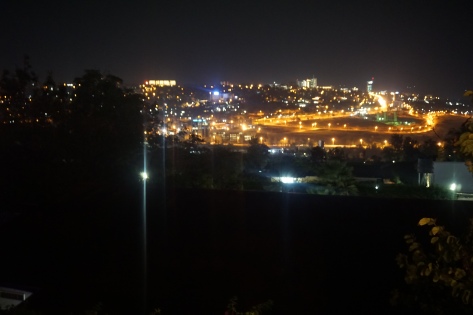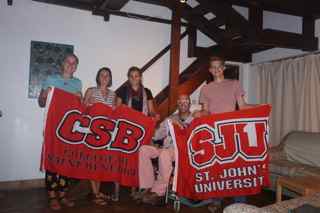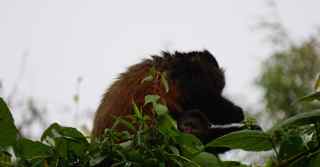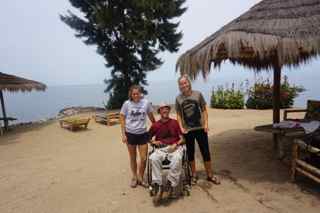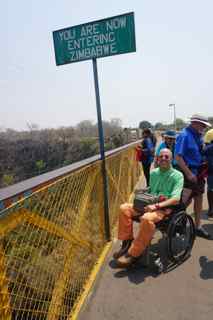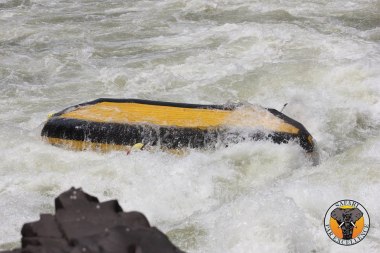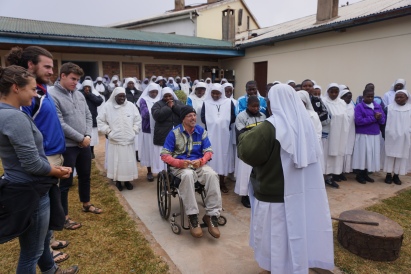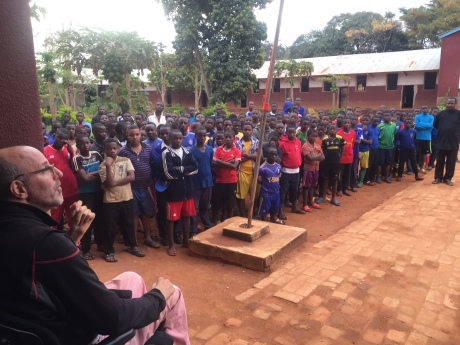Over the last month or so since I wrote last, we have been on whirlwind tour of India and Nepal (We have stayed in 9 different cities!). Our only true “down” day was spent in Kochi on a day between our time in Kathmandu, Nepal and Kerala, India and I unfortunately spent most of that day in our hotel bathroom on an AirIndia airline food induced 24 hour body cleanse. The point is, life has been busy! But, I am excited to get all of you caught up, so, without further ado, check out all the cool places we have been and cool things we’ve been doing!
Where?: Kappadu, Kerala, India
Overview: Kappadu is home to a Benedictine monastery with around 20 brothers. The head of the monastery, Abbot John, is old-school and no-nonsense, but he is very well respected and has kept the monastery running smoothly for over 20 years. The monastery in Kappadu serves as a sort of “in-between” house. While there are about 2 postulants (monks who have yet to make final vows), and a couple of priests, the large majority are brothers between 20 and 25 years old, who have made their final vows as monks and are studying to be priests (in fact, all of the brothers here are studying to become priests). Of any of the monasteries we have visited thus far, this one seemed to be the most strict, and the most direct replication, at least in terms of their schedule, in following the Rule of Benedict. The monks followed a strict schedule that included prayer 4 times a day, and 3 meals which are all taken in silence (they were only permitted to talk during their tea-time). Their day is otherwise generally divided into a morning block of classes (the monks are all either studying philosophy or theology, and will continue both studies before becoming priests), and an afternoon block spent doing manual labor, such as herding the goats, tending cows, or helping with other farming tasks [the Abbot requires that all the monks start out doing manual labor jobs, which, one older priest told us, is becoming more of a challenge for the young men as fewer and fewer come from traditional farming backgrounds]. However, the monks also get a short activity time in the afternoon where they all head down to play volleyball. Hannah and I felt we were largely viewed as a bit of a nuisance and distraction by Abbot John (which was perhaps true, as the monastery doesn’t get many young guests, and the monks always seemed eager to be able to come talk to us when they were out of earshot of the abbot), but since meals were silent, we always made an effort to go down and watch the volleyball games, giving us a chance to get to know the brothers, if just a very little bit.
Highlights:
Unlike some of other monasteries we have visited, the monastery in Kerala does not run a school, clinic, or orphanage (they do run a large boys hostel), which means there wasn’t much for us to do during the days. But, luckily, they were nice enough to set up a couple of day trips for us, so we could see the surrounding area.
On valentines day, we spent the day shown around by Father Bibin. One of the coolest parts of the day was going to Kurishumala Ashram, which is a unique benedictine monastery where the monks follow the beliefs of benedictine Catholicism, but have blended them with the traditional dress, decor, and rituals of Hinduism. For example, instead of pews in their chapel, the monks sit on the floor for prayer.
During the same day, our driver, a very smiley middle aged man with broken English, was so excited to be with us that he took us to his own home (a beautiful, large home he has recently built) to show us around, introduce us to his wife, and serve us tea and snacks.
In another outing they planned for us, we got to take a river boat down the Allepey river which allowed us to see the surrounding area including the homes and people, who largely live as fisherman and rice farmers, as well as the gorgeous, green surrounding area in Kerala. For lunch, we got served a traditional meal of rice and curry on giant banana leaves!
Fun Fact:
The boys hostel run by the brothers in Kappadu is home away from home for boys from all religions. So, at evening prayer, at which the boys attendance is required, the church also serves as temple and mosque.
This slideshow requires JavaScript.
Where?: Kathmandu, Nepal
Overview:
The e-visas we got to enter India only last for 30 days, and since we planned to stay about 3 months in India, we had leave the country to get new, longer visas. To make it all work, Bob bumped up a short trip he planned to Nepal, with the hope that we could quickly get new visas, and return to Kerala for another week. Unfortunately, when we arrived, we discovered that the visa process at the Indian embassy was not easy and it would take us multiple attempts and just over a week of waiting time. On the plus side, we had a great time in Nepal!
Kathmandu is a lively city filled with dread heads and trekkers stopping through on their way to Everest base camp or another long hike through the Himalayas. The crowded streets are overrun with cars, motorcycles, and bicycle rickshaws, and lined with at least two stories of shops, restaurants, and bars on each side. Nepal is about 80 percent Hindu and 10 percent Buddhist (with smaller Christian, Muslim and other minorities); I loved that nearly everywhere we went, there were multi-colored Hindu prayer flags fluttering overhead. We also had the chance to visit a Buddhist stupa nearby, where we watched a procession of tiny Buddhist monks (some as young at 5!); as well as a Hindu temple that was surrounded by Hindu holy men, or Sadhu, as they prepared for the lord Shiva’s birthday. Still, not to give too romanticized a picture of the city, I also have to admit that the constant traffic has no doubt been a large contributor to the thick smog that covers the city, driving many people in the city to walk around with face masks. And, though tourism to the country seems to be flourishing, the country, especially in the more rural areas, is still recovering very slowly from the massive earthquake that hit in 2015, and thought the temples and stupas are beautiful, many ancient relics are still crumbling and surrounded by scaffolding, while in various states of repair.
- Highlights:
Our visit to the birthplace of Buddha (a fact that was touted on many a car bumper sticker) inspired Hannah and my inner yogis, and on a few occasions we had the chance to practice yoga at a studio nearby our hotel.
- I have to give a shoutout to our hotel staff, who were absolutely awesome, and helped us plan so much of our impromptu trip. We even got a picture with our favorite guys, two Hindu Brahman, on our last day.
This slideshow requires JavaScript.
Where?: Pokhara, Nepal
Overview:
Since we had 5 days of waiting time before finally getting the visas forms correct and submitted, and picking up the actual visas, the hotel helped us plan a trip to Pokhara. Pokhara is a large city in Nepal located next the Phewa Lake, at the base of the Himalayas. Many trekkers come through Pokhara because it is the starting point for the very popular Annapurna circuit (after meeting two women who were there to hike the circuit, Hannah and I decided we’re also going to make the trip when we’re 30 to hike it; we were promised if we get 5 more people we get a discount so, let us know sometime in the next 6-8 years if you’re interested). Aside from hikers though, the area also has plenty of beautiful views, and temples to see, as well as other adventure activities, so many other tourists, including lots of families from China and India come to visit.
Highlights:
- The biggest highlight by far has to be going paragliding! An adventure sports shop nearby was initially extremely hesitant about bringing Bob, but, as usual he was adamant and persistent, until eventually they agreed. Hannah and I were nervous, not knowing exactly what difficulties he might face in taking of and landing since he would not be able to run along with his buddy paraglider in take-off, and would have to land on his butt rather than he feet at the end. But, they staff helped lift him and ran alongside at take-off and the landing was slow and smooth. We also picked a perfect morning! Since we were visiting out of season (the best season being from October to December), the mountains, despite being so close, are not always visible. But, the day we chose was possibly the least foggy of our trip, and as we were paragliding, we had a beautiful view of the snow-capped mountains. The only downside to paragliding was that I got a bit airsick, and lost my breakfast at landing…
- While driving back from Pohkara to Kathmandu, we stopped and climbed through Siddha cave, which is the largest cave in Nepal and the second largest in southeast Asia. The cave is over 1,000 feet long and over 150 feet high! When you get into the back of the cave, and turn off your flashlights, it feels like an empty void, where you cannot see or hear anything.
One of my favorite temples was Swayambhunath, or monkey temple. Which is a giant white and gold temple, adorned with prayer flags. One of the funniest surprises, was when, at the top (over 300 stairs up), Hannah and I walked out of a shop to see Bob sitting there. Not one to miss out, he paid some local guys to carry him up.
Reality Check:
One morning, since Hannah wasn’t feeling well, and Bob, despite the fact he wears hiking boots every day, isn’t a great hiker, I took a hike to the World Peace Pagoda with our driver. On the way up, he asked me if I hiked often, and I asked him the same in return, to which he told me that he goes hiking every month. There are no buses that go to his home village, so he hikes home 2 hours every month to see his wife and four year old son. He didn’t say it in any sad way; he was truly just answering my question about hiking, but it struck me as one of so many moments on this trip where I come face to face with how unbelievably lucky I am.
This slideshow requires JavaScript.
Where?: Kochi, Kerala, India
Highlight: Nice hotel with fluffy robes (I really don’t have much more to say because we basically stayed in Kochi for two nights before taking early flights, but I will not leave any cities visited out!).
Low point: Food poisoning 😦
Story time! (aka a short vent session on the struggle of being a passenger in a wheelchair flying through Indian airports): While this is not about Kochi, in particular, the only reason we stayed in Kochi, was for the airport, so it seems like an appropriate spot to talk generally about airports in India (Dehli, Kochi, Mumbai, etc.)— namely that they are the WORST. I should clarify here, that they are actually very nice airports, especially the Mumbai airport, which is basically a museum. However, every time we pass through an airport, it seems as though no one in a wheelchair has ever traveled through India. At every security check, they demand, often angrily, that Bob stand up. Once they even told him that it was a requirement that he be able to stand for 1-2 minutes for a security check. When he tells them he actually cannot stand, the staff always seem baffled. Though, perhaps not as baffled as the workers in charge of the wheelchairs used to shuttle us to and from planes during layovers. While these workers, and wheelchairs, generally seem plentiful at all the airports, they are typically used to bring elderly people who have a hard time walking to the plane, at which time they will stand up, walk over to a seat, and wait to walk the short distance down the aisle of the plane when it arrives. When faced with someone like Bob who cannot walk at all, they don’t know what to do. Multiple times, while we have had long layovers, they have refused the leave a wheelchair with us, insisting that Bob has to get into a regular chair and wait there until the flight (even if the wait is several hours) meaning he couldn’t go down to the bathroom or run and grab food. We have had to get higher management involved simply to be able to continue to use the wheelchair they brought us to the gate in (while watching other staff use wheelchairs as wheelbarrows to bring heavy poles and things around, showing there was definitely not a shortage). Needles to say, it can be extremely frustrating. OKAY. Now, my vent session is over. Now that I have expressed our airport woes, I can get back to all the fun travel stories.
Where?: Goa, India
Overview: As everyone should know by now, Bobby B. is a big fan of beaches, so, of course, we had to head to Goa, which is essentially one giant beach. We spent a week in there, and visited a different nearby beach every day. We spent the nights at a small hostel on Arjuna beach, and just enjoyed the casual atmosphere, often heading out to different restaurants on the water nearby and enjoying seafood while watching the waves (for most of this time, my stomach was still on the mend from my battle with food poisoning in Kochi, so some of us enjoyed the food a bit more than others… but, that’s not really the point. Still, I will accept e-sympathy cards if you would like to send them my way). Aside from soaking up the sun and waves, Hannah and I also had the chance to embrace the hippie culture in Goa, but attending yoga in an outdoor studio run by a dutch guy with long dreads and small photo shrine to Shiva, and the three of us spent the day at a giant local flea market where I got some shiny, fake gold ankle bracelets, so I could walk around feeling like an Indian princess.
Top Beach: The top beach award goes to Mandren Beach. This beach in the north was calm and peaceful without any vendors. A deep sand area carved out by the water also created a sort of calm ocean water lake beside the crashing waves, which means the three of us could sit in the warm ocean water and tan, without being smashed in the face by waves while trying to keep Bob upright in the water- a big bonus in an area where the waves seem to get pretty hectic.
Smile moment: My last story was about some not-so-understanding people at the airport, so I thought I would counter that with some good people. While on our trip, despite having lots of accessibility issues, and some lots of misunderstanding about disabilities in general, we have also found that people are often very kind and helpful to us. One moment that highlighted that was when we were trying to get over to Mandren beach. To get from the road to the beach, we had to pull the chair through a long path of thick dirt and sand, then carry it down lots of stairs, and drag it across the beach sand to an umbrella by the water. That day, two young guys helped us get there and back, without asking for a tip, and at the end even smiled and waved us off, saying “see you tomorrow”. And I know, they happily would have helped us all over again had we returned the following day. 🙂
This slideshow requires JavaScript.
Where?: Dehli, India
Overview: We spent just a few days in Dehli, but it was enough time to see the main tourist sights and most importantly to celebrate Holi! Rather than just list all of the tourist sites we hit, check out the captions on the photo reel below to see them for yourself!
Highlight:The highlight of our time in Dehli was definitely Holi. Holi is a hindu festival that people celebrate by throwing and smearing each other with bright powdery colors. The three of us got inexpensive white shirts for the occasion, so we could show off all the colors (and not worry about ruining our clothes). During the morning, we first grabbed some breakfast at a nearby hotel and cafe where we met a Swedish photographer who had been in the country going traveling to the biggest “Holi” celebration sites and snapping pictures for a week- he told us all kinds of cool stories and showed us some pictures, getting us excited for the day ahead. Afterwards, we grabbed our bags of colors and took a lap around the nearby area, smearing colors on the faces of people nearby and getting color scrubbed onto our foreheads and hair in return. Kids also ran around shooting water guns, and people tossed water balloons from rooftops. However, as it neared midday, the men in the streets became visibly drunker, women were basically nonexistent in the streets, and despite being a busy area in broad daylight with with plenty of police presence, it became clear that wandering around the streets was no longer a safe place to be if we didn’t want to be groped by creepy men. So, we retreated to our hotel and watched from our stairway where we met three people from the UK, who planned to spend the afternoon at the same music festival as us. The music festival had live performances, food stands, and buckets full of colors to throw. It was filled with foreigners, women, and children, and we knew we made the right choice. People all seemed thrilled to see a man in a wheelchair there and would excitedly say hello; at one point, a group of men even hoisted Bob’s chair up in the air and he danced and cheered from above the crowd. The crowd surfing moment served to make Bob, essentially a local celebrity that everyone wanted to meet and say hello to [basically, it was a best case scenario for our narcissistic friend ;)].
**Highlight within a highlight: Many people we met referred to the day of partying and color smearing as “playing the Holi” or “playing Holi,” which we loved. Grown men would excitedly describe their plans to “play the Holi” and in the days after, when Hannah and my hair was still died from the colors, people would say to us, “I see you played the Holi!”
This slideshow requires JavaScript.
Where?: Jaipur, India
Overview: On our last night in Dehli, we were met by Bob’s college friend, Jeff, and his girlfriend, Becky. the following morning, all 5 of us took off for a trip to Jaipur, Agra, and back to Dehli (a trip called the Golden triangle). The car rides mostly consisted of us posing our most challenging medical questions to Becky, a doctor specializing in travel medicine and infectious diseases, and putting up with stories of Bob and Jeff’s previous travels. However, our time in the city, filled with cool forts and castles, is again best told with accompanying pictures, so check ‘em out below!
Highlight: We all got to ride elephants!
Call for Help to Any Friends Living Near the University of Cambridge!!!: The current King of Jaipur attends Cambridge. I am in need of assistance in contacting him, as I would like to be a queen. Thank you.
This slideshow requires JavaScript.
Where?: Agra, India
Overview: Agra was the second city on our trip with Jeff and Becky. The city is best known for the Taj Mahal, but it is also home to the Agra Fort, where the king who built the Taj Mahal lived, and Fatehpur Sikri, a small, walled-in, ancient city filled with ornate sandstone buildings and a mosque.
Highlight: The obvious highlight of Agra was seeing the Taj Mahal, which is truly spectacular. But, because of our fantastic tour guide, Agra fort came in a close second. Our smiley tour guide not only showed us around the fort, but he told us all about his arranged marriage (people have told us that in India, around 70 percent of people still have an arranged marriage, and 30 percent have “love marriages”’ people claim the arranged marriages actually last better, because they have the full support of both families, who will help, and asking questions to us (such as if it was true that men can marry other men and women can marry women is America, if people can live together unmarried, and if our family and town would be okay with us remaining unmarried, or if there was a lot of social pressure to be married like in India.
**Story time!
Since I found it interesting, I thought I would share a bit of this man’s marriage story with you (note: major paraphrasing is about to happen, but I am trying to stay true to the story as best I can!).
He says that a man, a sort of matchmaker, had somehow met him while he was studying history in Agra, and essentially thought he was a good catch. So, he informed a family that had a daughter that he knew in Dehli, that he knew a young man that could marry their daughter, and they should act quickly, because he is just a study now, but once he gets a job, his dowry price could skyrocket. When both parties seemed like they may be interested in finding partners for their children, the boys family sent about 20 members to the girls home in Dehli (the young man planning to be married, was not allowed. While he said it was not appropriate for him to ask if she was beautiful, especially to his father, uncles, or older brothers, he was able to get some info. from his younger brother-in-law that she was. When his family was happy, her family then sent a larger party, around 50 people, to his house. He said got all dressed up, and his mom told him to be quiet and not answer anything beyond the question that was asked so he didn’t screw it up. Both families decided they were happy with the match, and a wedding was planned. He said there was a bit of time before the actual marriage happened, because, while a man’s family would be fine marrying right away, the woman’s family needs to come up with the dowry. In his case, the dowry not only included money to the man’s family, but also a TV, and other items to furnish the new couples home. I can’t remember the exact details, but i believe in their case, the wedding was the first time they met. He said it was a beautiful wedding with hundreds of guests (he said because extended families are often close in India, weddings are always big), and everyone partied all night. However, he said that his wife cried the entire time, and continued to cry for two more weeks. Not knowing what to do, he called his mother-in-law, and who told him to send her back home for two weeks, giving her more time to adjust. When he called to come get her, she wanted more time; after over a month, the mother finally had to give her daughter some tough love, and tell her she had to start her new life as a wife. He said that some men would become angry at their wives if they cried like she did, but he knew that leaving home was hard for her, so he was understanding. Though, to this day, he says his own mother and family do not know that he allowed to go back to her own home for a month. After she came back home with him, our guide told us, she actually didn’t talk to him for the first 4 months of their marriage! Despite the rough start, he tells us that he and his wife are very much in love now. He spoke adoringly of his wife, now married for 8 years, and two young children, even showing us pictures, and seemed to laugh recalling that early difficult period. This is just one story of many, vastly different stories of arranged marriages in India, but I thought it offered a unique glimpse into the marriage culture in India.
-Taj Mahal, Agra Fort (cool guide who told us all about his arranged marriage and asked us Qs about US); fahtepor sikri (spell?)
Highlight: Taj Mahal
This slideshow requires JavaScript.
Where?: Mumbai, India
Overview: Mumbai seemed to be more what I pictured India to be. It is a large, bustling city, filled with a wide variety of people in clothing ranging from typical American styles, down to screen printed “New York” t-shirts, to the lungis, sarees, and salwar camise’s more traditional of India. The traffic is horrible (though, even so, the smog here did not remotely compare to Nairobi, and especially not Kathmandu). Though there seem to be few beggers, as we were told to expect in India, there are homeless people laying in the streets (as you similarly find in major US cities), as well as many people with small food or knick-knack selling stands along the crowded sidewalks. While we were there, we went to see a large memorial, where countless people asked for a picture with us (a common occurrence almost everywhere we go as white Americans traveling through Africa and southern Asia, and a request we find difficult to turn down when girls, older women, or small children are the ones who want to be in the photo). We also stopped by a market and perused the many gold shops, went to a Bollywood movie and even decided to take a tour of one of the slums.
Highlight: While tourism through slums, or other such tours where people and their homes are the “attraction” and western tourists are paraded through to snap pictures, can certainly be a touchy issue, I also think that when it is done right, it can be beneficial for both parties. In our case, we chose a company where the tour guide was a university student who lives in the Dharavi slum. The part time job giving tours helps him to pay for school, where he is studying finance. He, and the company, also viewed to tours as a way to get rid of the misinformation that many people have about many slums- as places that are merely sad, crime ridden, etc. and to expand people’s thinking of what a slum is- namely, that is not just a subject for sympathy, but a place where people live and make a living; there is also happiness and productivity in the slum. Much of the tour focused around bringing us to local business areas- such as an area that does leather work, and has even recently started up their own Dharavi brand, and to an area that recycles plastics. Because of these businesses, they explained that there are even some very rich people (the owners of leather or recycling production)- some even millionaires- that live in the slum. Getting the chance to see, meet, and talk in person with people who live in a slum can be a powerful way to challenge our narrow perception of what slum life is, and I am personally so glad we made the decision to go.
*Special side note: the company was awesome in taking on the challenge of allowing Bob to go on the tour, and finding ways to use a car, and some alternate paths, to make the tour work despite the narrow dirt roads, they initially though may be too difficult for a wheelchair to navigate.
Fun facts:
- Our driver for the tour was the uncle of the young boy in the new Oscar nominated movie “Lion” (the little boy actually lives in a Mumbai slum).
–
- Dharavi slum (where we did our tour) was the site of the slum scenes in the movie “Slumdog Millionaire”
- Our guides, however, said they weren’t fans of either movie, as they paint a very sad, one sided picture or slum life. When asked for a good movie about India, they suggested “My Name is Khan,” which is a 2010 Indian drama that tells the story of an Indian muslim man who travels across the country to meet with president Obama.
Our first Bollywood Experience:
We headed to a large Mumbai theater to see “Badrinath Ki Dulhania,” a Bollywood movie about a strong-headed, educated, modern woman, and a traditional, masculine man, who fall in love. Before the show starts, as a part of a law in India, everyone stands while the national anthem plays and a giant waving flag plays on the screen. Before this particular movie, in place of the “No animals were harmed in the making of this movie” warning, a warning popped up stating that the production company does not support the practice of Dowry and supports section 498 of the Indian Penal Code protecting against dowry harassment- the first time we were made aware that the practice of dowries is actually illegal in India (this was later confirmed by the head of our tour company, who said that people sometimes use other language such as referring to it as a “gift,” and that the police generally don’t enforce it.) The movie was all in Hindi, but we still enjoyed the singing, dancing, and bright colors of the movie. It also didn’t prevent us from following the basic plot- which we later confirmed by a google search and by questioning some other hindi speakers who had seen the movie- which, as far as its statement on women’s right seemed questionable at best. Essentially, the movie opens by describing baby boys as an asset, and baby girls as a liability. Then showing a family cheering the birth of a boy, and crying at the birth of a girl. The first have of the movie, follows a standard jock-boy gets smart, beautiful girl to fall for him plot of just about every teenage rom-com. But, just before intermission (yep! There is an intermission; while in Sri Lanka, Hannah and I also went to a movie, and were totally confused when the screen abruptly went black, so we were more prepared this time), the boy is left at the altar, as the girl decides to leave the country to pursue a job as a flight attendant in Singapore instead. When the movie resumes, the boy tracks her down in Singapore, seems to stalk her, throw her in a trunk, and otherwise harass her. We were assured by others, because we cannot understand what she says, that she was upset with this. But, nonetheless, she clearly bails him out from the police, lets him stay with her, and eventually falls in love and marries him. Asking our guide the following day, he seemed to feel it was justified because he was angry with her for embarrassing him at the wedding, and that, he comes from a traditional family, but he does learn how to treat her well. The point is, I have very mixed emotions about my first Bollywood experience, but, that being said, if any of you are Bollywood fans, and have some suggestions for me that might change my mood, I am down to give it a second shot!
Some final notes and thoughts on this whole arranged marriage thing:
- Though giving dowries is still widely practiced, some men do choose not to accept any money; one of our guides told us that his family is against it, and so neither he or his brother took any major gifts or money when they were married; perhaps, the times are changing, and slowly, women will be less of a burden to families in India.
- Love marriages do happen! In Mumbai, a large, progressive city, some people we met estimated that around 40-50 percent of young people now have so-called “love” marriages. Our 18 year old slum tour guide also said that many young people will go out on dates, and just not tell their parents (if they fall in love, they may then try to convince their parents to allow them to marry).
In cases where people have trouble finding a match (perhaps because they are a bit older- which may cause speculation that they are a bad match [why haven’t they married yet!], or have a questionable family [what?! their first child ran off in a love marriage!], people can use the power of the internet! Apparently there are sites families can use to help arrange a good marriage.
- The amount that the couple knows each other, gets to spend time together before the wedding, or gets to be a part of choosing their own partner seems to vary widely on the family, religion, and area of India. Sometimes, marriages could be arranged from when the children are very young, and it could even be a person they knew growing up other times, a person may be older and might help the family in looking through potential partners online. Sometimes they do not meet at all before the wedding, sometimes they meet a few times, and get to be an active participant in choosing if they are interested, in other cases, they can go on unlimited dates, unchaperoned, so long as they are already engaged. And there are countless other options in-between.
Mom, please do not take this as an opportunity to set me up in an arranged marriage. Unless, the man you find is actually a very rich King, then, I’ll think about it.
This slideshow requires JavaScript.
Signing off from Myanmar! For those of you who made it all the way to the end of this unbelievably long post- God bless you. May the donuts and flaky croissants in your life be plentiful. ❤
